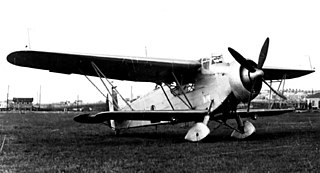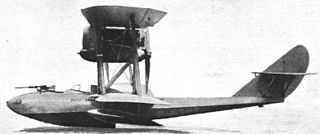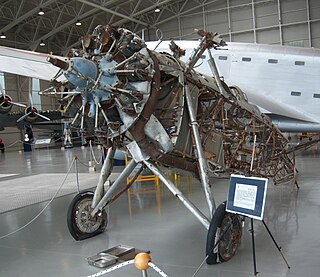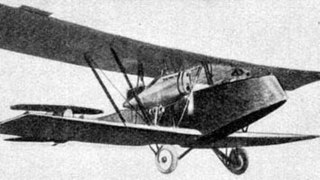Operators
 Kingdom of Italy
Kingdom of Italy
| IMAM Ro.26 | |
|---|---|
| Role | Trainer |
| National origin | Italy |
| Manufacturer | IMAM |
| Designer | Giovanni Galasso |
| First flight | 1932 |
| Number built | 1 |
The IMAM Ro.26, sometimes called the Romeo Ro.26, was a single-engine biplane trainer aircraft produced by the Italian aeronautical company IMAM in the early 1930s. Only one example was built.
At the beginning of 1932, the Italian company SA Industrie Meccaniche e Aeronautiche Meridurali (IMAM) manufactured the Ro.26 biplane, a basic trainer aircraft based on a design by aeronautical engineer Giovanni Galasso. [1] It was powered by a seven-cylinder, 215-horsepower (160 kW) Armstrong Siddeley Lynx radial engine, built under licence by Alfa Romeo as the Lince. [1] IMAM intended to market the new aircraft for basic pilot training and use in aerobatic competitions. [1] The Ro.26′s design also allowed it to serve as a trainer for seaplane pilots by converting into a floatplane as the Ro.26I — or Ro.26 Idro ("Hydro") — with the landing gear replaced by floats. The prototype, registered as I-ABIL, flew for the first time in 1932. [1]
The Ro.26 was a biplane trainer aircraft with equal-span wings with a slight upward cant. [2] The wings and tail section were of all-wooden construction and covered with canvas. The fuselage was of all-metal construction, built with autogenously welded steel tubes. [2]
The aircraft had fixed, wide-track rear tricycle landing gear with oil-elastic shock absorbers. A pair of floats could replace the landing gear in order to transform the aircraft into a floatplane. [2] The open cockpits were arranged in tandem, with the instructor placed in the first cockpit, accessible from a door positioned on the right side of the fuselage. The pilot in the forward cockpit could engage and disengage the flight controls in flight at will. [2]
The Alfa Romeo Lynx seven-cylinder, air-cooled engine was rated at 215 horsepower (160 kW) and drove a helical wooden two-bladed propeller that was 2.180 m (7 ft 1.8 in) in diameter. [2]
At the beginning of 1934 the Regia Aeronautica (Italian Royal Air Force) tested the Ro.26 prototype I-ABIL. [1] Although the aircraft displayed good flight characteristics, the military authorities decided not to buy it. [1] IMAM abandoned plans for series production and built no additional examples. [1]
The floatplane version had a maximum speed of 205 kilometres per hour (127 mph) and a stall speed of 82 kilometres per hour (51 mph), and could climb to 1,000 m (3,300 ft) in 3 minutes 20 seconds, to 2,000 m (6,600 ft) in 7 minutes, to 3,000 m (9,800 ft) in 13 minutes, to 4,000 m (13,000 ft) in 21 minutes 30 seconds, and to 5,000 m (16,000 ft) in 34 minutes. [3] "I" stood for Idrovolanti ("seaplane").
Data from Jotti da Badia Polesine [2]
General characteristics
Performance

The Savoia-Marchetti SM.75 Marsupiale was an Italian passenger and military transport aircraft of the 1930s and 1940s. It was a low-wing, trimotor monoplane of mixed metal and wood construction with a retractable tailwheel undercarriage. It was the last of a line of transport aeroplanes that Alessandro Marchetti began designing in the early 1930s. The SM.75 was fast, robust, capable of long-range flight and could carry up to 24 passengers for 1,000 miles.

The Breda Ba.25 was an Italian two-seat biplane trainer designed and built by the Breda company. It was the most widely used Italian basic trainer of the 1930s.

The Meridionali Ro.37 Lince was a two-seater Italian reconnaissance biplane, a product of the Industrie Meccaniche Aeronautiche Meridionali (IMAM) company. It appeared in 1934 and had a composite structure of wood and metal. The aeroplane first saw operational duty in the Second Italo-Ethiopian War (1935–1936) and Spanish Civil War (1936–1939), and during the Second World War it saw duty on almost all fronts, except for Russia and the English Channel. It followed the Ro.1 as the main reconnaissance aircraft for the Italian Army.

The Caproni Bergamaschi AP.1 was an Italian monoplane attack aircraft designed by Cesare Pallavicino, coming from the Breda firm.

The Caproni Ca.309 Ghibli was an Italian aircraft used in Libya and North Africa from 1937 to 1943. Its nickname, 'Ghibli', refers to a Libyan desert wind.

The Caproni Ca.101 was a three-engine Italian airliner which later saw military use as a transport and bomber. It was designed in 1927 and first flown in 1928.

The IMAM Ro.51 was an Italian fighter aircraft that first flew in 1937. It was designed for the 1936 new fighter contest for the Regia Aeronautica, with practically all the Italian aircraft builders involved.

The IMAM Ro.30 was a 1930s Italian observation biplane designed and built by Industrie Meccaniche e Aeronautiche Meridionali. It was only built in limited numbers before being replaced by the Ro.37.

The SAIMAN 202 was a 1930s Italian two-seat cabin monoplane designed and built by the Società Industrie Meccaniche Aeronautiche Navali (SAIMAN).

The Savoia-Marchetti S.57 was an Italian single-engine biplane flying boat intended for aerial reconnaissance, built by Savoia-Marchetti for Regia Aeronautica after World War I.

The IMAM Ro.44 was a fighter seaplane developed in Italy, a single seater derivative of the Ro.43 that first flew in October 1936. While the Ro.43 had serious problems, the Ro.44 was an utter failure. Armed with two 12.7 mm machine guns fitted in the nose, the rear fuselage of the R.43 was redesigned to dispense with the observer's position, and changes were made to the tail. Overall, performance remained almost identical to that of the Ro.43, although the Ro.44 was more maneuverable.

The Breda A.14 was a prototype three-engined biplane, designed by Società Italiana Ernesto Breda as a night bomber in 1928.

Officine Ferroviarie Meridionali or OFM was an Italian railway and rolling stock manufacturing company based at Naples.
The Alfa Romeo Avio was an Italian aviation company producing aircraft engines active since 1941. It was founded as a division of Alfa Romeo but was sold to Aeritalia in 1986 and then to Fiat in 1996. It was merged with Fiat Avio in 2003 as Avio S.p.A.
The Caproni Ca.131 was a prototype for a large aircraft built in Italy in 1934, intended for use as either a bomber or airliner. It was a conventional low-wing cantilever monoplane, powered by a radial engine on each wing and in the nose. The main undercarriage was housed within large streamlined spats. Configured as an airliner, it would have seated 17 passengers.
The CANT Z.504 was a prototype reconnaissance biplane flying boat made by CANT in the 1930s.

The Caproni Ca.105 was a multirole high wing single engine monoplane developed by the Italian aeronautical company Aeronautica Caproni in the late 1920s.

The Piaggio P.IX, or Piaggio Stella P.IX, was an Italian nine-cylinder radial aircraft engine produced by Rinaldo Piaggio S.p.A. Based on the Gnome-Rhône 9K, the engine was rated at 600 hp (447 kW). Production was used to power a number of other aircraft developed in Italy. The main users were the Savoia-Marchetti SM.81 transport and the IMAM Ro.37bis, the main reconnaissance aircraft in the Regia Aeronautica during the Second Italo-Ethiopian War, Spanish Civil War and Second World War, but the engine was also used by other designs, including the prototype Savoia-Marchetti SM.79.

The Breda A.3 was a prototype twin-engined biplane, designed by Società Italiana Ernesto Breda, as a night bomber in 1924.
The Breda A.1 was a touring aircraft developed in Italy in 1924.